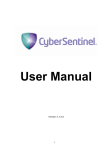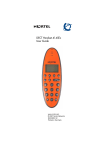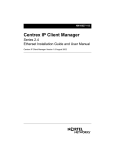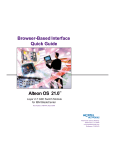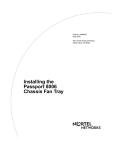Download Nortel Networks Ventilation Hood ipView Software Wallboard User's Manual
Transcript
Return to Menu Nortel Networks ipView Software Wallboard Set Up and Operation Guide www.nortelnetworks.com © 2002 Nortel Networks P0988907 Issue 04 (06) 2 Table of Contents Table of Contents How to use this guide........................................................................ 3 Introduction .............................................................................................................3 How this guide is organized....................................................................................3 System Overview ............................................................................... 4 Introduction .............................................................................................................4 Overview .................................................................................................................4 ipView Languages ..................................................................................................4 PC requirements .....................................................................................................5 Operating System Requirements............................................................................5 Operating System Compatibility .............................................................................5 Installing ipView................................................................................. 6 Installation of the ipView Software Wallboard ........................................................6 Installing Nortel Networks ipView Software Wallboard......................................6 Using ipView ...................................................................................... 8 Starting the ipView SoftBoard.................................................................................8 Short View...............................................................................................................8 Shutting Down ipView...........................................................................................10 Long View .............................................................................................................11 Message View.......................................................................................................12 Parameter View ....................................................................................................13 History View ..........................................................................................................13 Summary View......................................................................................................14 Tooltray Icon .........................................................................................................15 Re-play Summary ............................................................................................16 Configuration ...................................................................................................16 About ipView....................................................................................................16 Close ipView ....................................................................................................17 Configuring ipView .......................................................................... 18 Introduction ...........................................................................................................18 Accessing the Configuration Property Pages .......................................................18 View Tab ...............................................................................................................19 View Options....................................................................................................19 Always On Top Options ...................................................................................20 Last Position Options.......................................................................................20 Graphing Tab ........................................................................................................21 Trend Graph Colours .......................................................................................21 Summary Options ............................................................................................22 Echoing Tab..........................................................................................................24 Data Echoing Options......................................................................................24 Index ................................................................................................. 26 Issue 04 Nortel Networks ipView Software Wallboard Set Up and Operation Guide How To Use This Guide 3 How to use this guide 1 Introduction This guide is designed to assist a System Manager in the installation, set up and operation of Nortel Networks ipView Software Wallboards. Use this guide as an ongoing reference. This chapter tells you what to expect as you read this guide and how information in this guide is presented. How this guide is organized The Nortel Networks ipView Software Wallboard Set Up and Operation Guide is organized according to the following chapters: How to use this guide — provides a brief overview identifying the organization of this guide. System Overview — describes the overall functionality of Nortel Networks ipView, and describes the minimum PC and Operating System requirements of ipView. It also describes the Operating System compatibility of ipView. Installing ipView — describes installation prerequisites and how to install the Nortel Networks ipView software. Using ipView — describes starting to use Nortel Networks ipView, including starting and closing ipView. This chapter also explains the different views within ipView. Configuring ipView — describes how to configure ipView with your preferred operational settings. Issue 04 Nortel Networks ipView Software Wallboard Set Up and Operation Guide 4 System Overview System Overview 2 Introduction Nortel Networks ipView Software Wallboard is a Windows® software application that provides a software based IP enabled wallboard on the PC desktop of Call Center Agents. Nortel Networks ipView Software Wallboard is often referred to as the ipView SoftBoard. Overview Call Center Statistics and Messages from the Nortel Networks Call Center Reporting application are displayed in Real Time on the ipView SoftBoard. Audible Alerts can be associated with certain events, and histograms can be displayed to graphically show the changes in a particular Call Center parameter over a rolling period of 15 minutes. Configuring Nortel Networks Call Center Reporting to operate with ipView is exactly the same as configuring Nortel Networks Call Center Reporting to operate with a hardware wallboard. (See the Nortel Networks Call Center Reporting Set Up and Operation Guide, Chapter 6: Wallboards). The ipView SoftBoard is completely compatible with the ipView Hardware wallboard, and a mixture of ipView hardware wallboards and ipView SoftBoards can be configured within the Nortel Networks Call Center application. Additionally, ipView SoftBoards can relay their input to any number of other IP enabled wallboards, either ipView hardware wallboards or ipView SoftBoards. ! On-Line Context-sensitive Help is available within ipView by pressing the F1 key. ipView Languages Note that you can have the ipView SoftBoard operating in English, French, Spanish, Italian or German. Furthermore, it does not have to operate in the same language as the Nortel Networks Call Center Reporting MIS. This allows you to install different language versions of the ipView SoftBoard amongst your Call Center Agents. Nortel Networks ipView Software Wallboard Set Up and Operation Guide Issue 04 System Overview 5 For example, you may have your Nortel Networks Call Center Reporting application operating in the French language, and have a mixture of English speaking and French speaking Agents. You could install a mixture of ipView SoftBoards, in English and French, amongst your Call Center Agents, as appropriate. Although (in our example) the Nortel Networks Call Center Reporting application will transmit the wallboard statistics in French, the ipView SoftBoards operating in English will locally translate the received parameter abbreviations and long descriptions into English before displaying them to the Agent. PC requirements Component Platform Microprocessor Microprocessor speed RAM Free hard disk space Network Interface Network Protocol Display Type Display (Graphics) Card Specification IBM™ Compatible PC Pentium 1 (or equivalent) minimum 200MHz minimum 16Mb minimum 2Mb minimum Network Interface Card TCP/IP protocol SVGA display SVGA graphics card Operating System Requirements ipView will operate on the Windows 95TM rev B (or later version) operating system. Operating System Compatibility ipView has been verified for correct operation on the following Operating Systems: Operating System Windows 95 Windows 98 Windows Millennium Edition Windows NT Windows 2000 Windows XP Professional Issue 04 Version 4.00.950 B 4.10.2222 A 4.9.3000 4.00.1381 5.00.2195 Version 2002 Nortel Networks ipView Software Wallboard Set Up and Operation Guide 6 Installing ipView Installing ipView 3 Installation of the ipView Software Wallboard You can install the ipView SoftBoard onto any PC Desktop that is connected via the network to the Nortel Networks Call Center Reporting Master Client PC, with the TCP/IP protocol. Note that you can have the ipView SoftBoard operating in English, French, Spanish, Italian or German. It does not have to operate in the same language as the Nortel Networks Call Center Reporting MIS. This allows you to install different language versions of the ipView SoftBoard amongst your Call Center Agents. To install the ipView SoftBoard onto an Agent desktop, go to the Agent PC and perform the following steps. Installing Nortel Networks ipView Software Wallboard 1. Exit any Windows programs that are running. 2. Start your internet Browser (such as Internet Explorer or Netscape), and use it to connect to Port 6800 on the Business Communications Manager. Do this by entering into the browser Address Bar the IP Address of the Business Communications Manager and the Port number, in the following format: http://10.10.10.1:6800. (Remember to substitute the IP Address of your Business Communications Manager for the 10.10.10.1 shown in the example above.) 3. Nortel Networks Unified Manager page will appear in the browser. 4. Click on the Install Clients link. 5. The Install Clients page will appear in the browser. 6. Click on the web link to download ipView. (You may need to scroll down through the page to see the buttons which download ipView.) 7. Click on the Install ipView button. 8. A dialog will appear from which you can select to either Run this program from its current location or Save this program to disk. The default option is Save this program to disk. Click on OK. Nortel Networks ipView Software Wallboard Set Up and Operation Guide Issue 04 Installing ipView 7 9. Several progress bars appear as the installation routine prepares itself. Presently the Nortel Networks ipView SoftBoard language selection dialog appears. Select the language you wish to install, and then click OK. 10. The ipView Splash Screen and the Welcome screens appear. 11. The Choose Destination Location window appears. 12. Click Next to accept the default location. To change the folder location, click Browse, choose another folder location and then click Next. 13. Select the language in which your copy of Nortel Networks Call Center Reporting Master is running. ! Note that this is not the language in which you wish ipView to operate. The language in which ipView will operate was selected in step 9. This step tells this copy of ipView what language the data being sent to it by the Nortel Networks Call Center Reporting Master PC will be in. This allows ipView to translate it (if required) into the language selected in step 9. 14. When the installation routine has finished, the Setup Complete window appears. Issue 04 Nortel Networks ipView Software Wallboard Set Up and Operation Guide 8 Using ipView 4 Using ipView Starting the ipView SoftBoard Double-click on the ipView icon on the PC desktop. Short View The ipView window will appear. The first time you start ipView it will open in its default view, which is the Short View (Diagram 1). Diagram 1: ipView First Time Start Up ! Note that each time you start ipView the parameter values will be blank until ipView has received some data from Nortel Networks Call Center Reporting or another ipView SoftBoard which is echoing to yours. (For a description of echoing, see page 24.) If the IP address of your copy of ipView has been configured in the Wallboards Tab of the Nortel Networks Call Center Reporting Configuration, and the Nortel Networks Call Center Reporting application is operational, presently ipView will start to display information. The information it receives will depend on what has been configured by the System Manager of the Nortel Networks Call Center Reporting application. A typical ipView display is shown in Diagram 2. Nortel Networks ipView Software Wallboard Set Up and Operation Guide Issue 04 Configuring ipView 9 Diagram 2: Typical ipView Display. To better understand what the abbreviations represent, point to one of the abbreviations and you will see a ‘tip’. See Diagram 3. Diagram 3: Short View With a ‘Tip’ If the System Manager of the Nortel Networks Call Center Reporting has set a threshold for any of the parameters which are being displayed on your copy of ipView and one of those parameters exceeds that threshold, the parameter value will be displayed in blinking red. In Diagram 4, a call has waited in the Queue for a period of time in excess of the threshold set by the System Manager. The Parameter is said to be ‘in the alarm state’. If the System Manager has configured it, there may be an associated audible alert. Issue 04 Nortel Networks ipView Software Wallboard Set Up and Operation Guide 10 Using ipView Diagram 4: Short View with a Parameter value in Alarm. Shutting Down ipView To shut down ipView, left-click with the mouse on the button top-right in the ipView window, as shown in Diagram 5. Diagram 5: ipView Close Button. You will be presented with a small dialog box asking you to confirm that you wish to close down your copy of ipView, as shown below in Diagram 6. Diagram 6: Confirm Close dialog. Click on OK to close ipView, or click on Cancel to leave ipView running. Nortel Networks ipView Software Wallboard Set Up and Operation Guide Issue 04 Configuring ipView 11 Long View You can set ipView to operate in another view, called Long View. In Long View the two-letter abbreviations for the parameters are replaced by longer descriptions. When you first start to use ipView you may find it convenient to use the Long View until you become familiar with the parameters that are being sent to you from the Nortel Networks Call Center Reporting. To select Long View, right-click in the ipView window and a small menu will appear. See Diagram 7. Diagram 7: The Right-Click Menu, Set Long View highlighted. The first option is Set Long View. Selecting this will cause ipView to adjust its view to the Long View. See Diagram 8, below. Diagram 8: Long View. As you can see in Diagram 8, the abbreviations have been replaced by longer descriptions which inform you of the exact nature of the value which is being displayed. Parameters which go into the alarm state are displayed in the Long View in the same manner as they are displayed in the Short View. See Diagram 9. Issue 04 Nortel Networks ipView Software Wallboard Set Up and Operation Guide 12 Using ipView Diagram 9: Long View with a Parameter in the Alarm State Message View If Nortel Networks Call Center Reporting sends a message to the ipView SoftBoard it is displayed in the Message View window. See Diagram 10. (Message View windows will appear whether ipView is currently in Short View or Long View.) Diagram 10: Short View with a Message View window. Messages may be sent from the Nortel Networks Call Center Reporting if: • A parameter goes into the alarm state and has a message associated with it • A scheduled message has been set to go at a certain time and that time has been reached • The System Manager or Skillset Supervisor decides to send a one-off message All of these messages will be displayed in a Message View window. Nortel Networks ipView Software Wallboard Set Up and Operation Guide Issue 04 Configuring ipView 13 The Message View window will be automatically removed when the message has been displayed for a short period. Parameter View By clicking with the left mouse button on one of the parameter values (that is, on the digits not the abbreviation or description) the Parameter View window will be activated. This will display the chosen parameter value in a large font so that an important parameter can be more easily monitored by a busy Agent. They need only glance at ipView to see the important parameter’s current value. Diagram 11 shows the Parameter View window with ipView in Long View. (Of course, the Parameter View window can be activated in either Long View or Short View.) Diagram 11: Parameter View window in Long View. To close the Parameter View window, click once more on the selected parameter value. Note: You do not have to close the Parameter View to change the displayed parameter. With the Parameter View displayed, to display a different parameter within the Parameter View window click with the left mouse button on the new parameter value. History View By clicking with the left mouse button on one of the parameter abbreviations or descriptions the History View window will be activated. This will display a histogram representing the chosen parameter showing a column representing the minimum and maximum values for each minute, for up to 15 minutes. This allows the Agent to see the current trend for a selected parameter. Issue 04 Nortel Networks ipView Software Wallboard Set Up and Operation Guide 14 Using ipView As each minute passes a new column will be added to the right hand end of the graph representing the minute which most recently expired. Previous columns will move to the left to make room for the new column. Diagram 12 shows History View graph with ipView in Short View. (Of course, the History View window can be activated in either Long View or Short View.) Diagram 12: History View with ipView in the Short View. To close the History View window, click once more on the selected parameter abbreviation or description. Note: You do not have to close the History View to change the displayed parameter trend. With the History View displayed, to display a different parameter trend within the History View window click with the left mouse button on the new parameter abbreviation or description. Summary View When the Nortel Networks Call Center Reporting application sends a summary to the wallboards, it sends the daily and hourly totals for the following parameters: • • • • Incoming Calls Outgoing Calls Abandoned Calls Grade of Service When a summary is received by ipView, it stores the hourly values so that when subsequent summaries are displayed by ipView it can show a series of four graphs showing the trend of the daily values of each of these parameters in turn. Diagram 13 shows a montage of the various graphs that are displayed. (Only one graph is displayed at a time. After a short duration the displayed graph is replaced by the next one.) Nortel Networks ipView Software Wallboard Set Up and Operation Guide Issue 04 Configuring ipView 15 The Summary View window will display itself whenever a summary is received from the Nortel Networks Call Center Reporting application, whether ipView is in Long View or Short View. Diagram 13: Montage of Summary Graphs with ipView in Short View. There is no need to manually close the Summary View. Once the final graph has been displayed for a short period the Summary View will be closed automatically. ! Note that the parameter values are removed for the duration of the summary. They will be re-displayed when the MIS next sends information to ipView. Tooltray Icon When ipView is running, a small ipView icon is placed in the Tooltray at the bottom right hand corner of the PC desktop, as shown in Diagram 14. Diagram 14: Typical Tooltray with the ipView icon next to the digital clock. Right-clicking with the mouse on the ipView tooltray icon will cause the menu shown in Diagram 15 to appear. Issue 04 Nortel Networks ipView Software Wallboard Set Up and Operation Guide 16 Using ipView Diagram 15: Tooltray Menu. Re-play Summary Selecting this option causes the Re-play Summary sub-menu to appear, as shown in Diagram 16. Diagram 16: Re-play Summary sub-menu. These options allow you to re-play the most recently received summary. You can choose to view All of the graphs again, or just select to re-play a single graph of interest, either: Incoming, Outgoing, Abandoned or Grade of Service. Configuration Selecting this option allows you to have access to the ipView Configuration Property Pages. Configuration is described in the section Configuring ipView, on Page 18. About ipView Selecting this option causes the dialog shown in Diagram 17 to appear. The details of your version of ipView may differ slightly than those shown here. Nortel Networks ipView Software Wallboard Set Up and Operation Guide Issue 04 Configuring ipView 17 Diagram 17: ipView About Box ! In order for the System Manager to configure your copy of ipView within Nortel Networks Call Center Reporting, they will need to know the IP Address of your PC. The ipView About box provides a simple and quick way of discovering your IP Address. Close ipView Selecting this option starts the shut-down process, in exactly the same fashion as if the button top-right on the ipView window had been clicked. (See Shutting Down ipView, page 10). Issue 04 Nortel Networks ipView Software Wallboard Set Up and Operation Guide 18 Configuring ipView Configuring ipView Introduction Many of the properties of ipView can be changed or customized, and ipView will remember the settings you have changed and will use these the next it is started. The settings and options are all located within the ipView Configuration property Pages. Accessing the Configuration Property Pages To access the Configuration Property Pages, right-click in the ipView window and a small menu will appear. See Diagram 18. Diagram 18: The Right-Click Menu, Configuration highlighted. The second option is Configuration. Selecting this will cause the ipView Configuration Property Pages to appear. (See Diagram 19.) There are three tabs within the ipView Configuration Property Pages. The options which can be selected and set are grouped together under these headings: • • • View Graphing Echoing The View Tab groups together options which relate to ipViews appearance and position on the PC desktop. The Graphing Tab groups together options which relate to ipViews graphs and sounds. Nortel Networks ipView Software Wallboard Set Up and Operation Guide Issue 04 Configuring ipView 19 The Echoing Tab groups together the options which control the echoing of the received data to other wallboards. View Tab The View Tab is shown below, in Diagram 19. Diagram 19: Configuration – View Tab. View Options ipView can be viewed either in Short View or Long View. In Short View abbreviations are used to display the parameter identity and in Long View more complete text descriptions are used to display the parameter identity. Most users start by using Long View for a few days until they get to know which parameters are being sent to them. Then they change to Short View, as this takes up less screen area. Issue 04 Nortel Networks ipView Software Wallboard Set Up and Operation Guide 20 Configuring ipView You can choose which view you prefer ipView to start up in each time ipView is launched. To have ipView start up in the Short View, click the Short View option radio button. To have ipView start up in the Long View, click the Long View option radio button. Always On Top Options When you have several programs running on your desktop their windows will overlap so that only a portion of some windows will be visible, because other windows are ‘in front’ or ‘on top’ of them. Some smaller programs may be completely obscured by other larger windows. The way in which ipView positions itself with respect to the windows of other programs can be specified. The options are: Always On Top The ipView window is always visible, it stays ‘in front’ of all other application windows, even when the other applications are the currently active window. This allows you to be using a full-screen application and still see the ipView window. Never On Top The ipView window is only visible when there are no other applications or windows opened ‘on top’ or ‘in front’ of it. On Top For Alerting This option behaves like the Never On Top option, except that if ipView receives either a text message or a summary, or a parameter goes into the Alarm state, the ipView window will move to the front so that you can see it. Using any of the windows of the other applications causes them to move in front of the ipView window once again. Last Position Options ipView can be configured to start up at either its default location (top-right on the desktop) or the screen position at which ipView was previously closed down. To have ipView start up at its last screen location, click the Open at last location option radio button. To have ipView start up in the default location, click the Open at default location option radio button. Nortel Networks ipView Software Wallboard Set Up and Operation Guide Issue 04 Configuring ipView 21 Graphing Tab The Graphing Tab is shown below, in Diagram 20. Diagram 20: Configuration – Graphing Tab. Trend Graph Colours The colours used in the History View trend graph for the Maximum and Minimum portions of the histograms can be defined. The colours currently being used are displayed. To specify the colour used for the Minimum portion of the trend graph columns, click on the Change button beside the Minimum Colour option. To specify the colour used for the Maximum portion of the trend graph columns, click on the Change button beside the Maximum Colour option. Issue 04 Nortel Networks ipView Software Wallboard Set Up and Operation Guide 22 Configuring ipView Summary Options Display Range Summaries can be configured to show the previous 12 hours or the previous 24 hours. Select either 12 Hour or 24 Hour from the Display Range drop-list. Re-play Duration The most recent summary can be replayed by right-clicking on the ipView icon in the tooltray, and selecting the Re-play Summary option. When you select to Replay All, the Incoming Summary, Outgoing, Abandoned and Grade of Service summaries are displayed in turn. You can specify the period each of these summaries is displayed for, by selecting 10 sec, 15 sec, 20 sec, 25 sec or 30 sec from the Re-play Duration drop-list. Sound Options When a parameter enters an alarm state, or a Summary is received (or replayed) ipView will provide an audible alert. ! Note that this is dependant on the System Manager specifying in the Configuration of the Nortel Networks Call Center Reporting application that your SoftBoard should receive audible alerts. The audible alert can be configured to be a simple default bleep or a sound file (.WAV) can be specified. Different (or the same) sound files can be played for Alarm alerts and Summary alerts. The audible alert can also be turned off. To turn off the audible alert, click the radio button beside the ‘crossed speaker’ icon. To specify whether to play the default bleep or a sound file click on either the Default Bleep option radio button or the Sound File option radio button. ! Note that the way your PC reacts to the default bleep depends on the way your Sounds have been mapped within your PC. For example, Microsoft Themes may re-map your sounds in such a way that the default bleep is inaudible. If you cannot hear the default bleep option, use the Sounds option within Control Panel to map the default system sound to something which is audible on your PC. The sound of the default bleep also depends on whether your PC is fitted with an internal speaker or a ceramic buzzer. One some PCs the default bleep is a barely audible ‘click’ sound. In these circumstances it is preferable to play a sound file. Nortel Networks ipView Software Wallboard Set Up and Operation Guide Issue 04 Configuring ipView 23 If you select the Sound File option, the Alarm File and Summary File Browse buttons become active. They become inactive if the Default Bleep option is selected. When the Sound File option is selected the Browse buttons can be used to browse your hard disk to select a sound file (.WAV) that you wish to use as the Alarm or Summary audible alert. Issue 04 Nortel Networks ipView Software Wallboard Set Up and Operation Guide 24 Configuring ipView Echoing Tab The Echoing Tab is shown below, in Diagram 21. Diagram 21: Configuration – Echoing Tab Data Echoing Options The ipView running on one computer can be configured to send any information it receives to other copies of ipView running on other computers, or to ipView physical (hardware) wallboards. This is called ‘echoing’. There is no limit to the number of copies of ipView (or ipView physical wallboards) that can be echoed to. Nortel Networks ipView Software Wallboard Set Up and Operation Guide Issue 04 Configuring ipView 25 To configure ipView to echo to other wallboards, click the Send to other wallboards option checkbox, to place a tick in the checkbox. (When this option is checked, the Data Echoing IP Address List and its Add and Remove buttons become active.) Port Number You will not normally need to change this value. This is the Port number on which the ipView software will listen for incoming data, and which it uses to echo to other wallboards. It may require changing if you wish to address wallboards that are on the other side of a firewall, and your network administrators have decided on a particular range of Port numbers which software must use in order to communicate through the firewall. If your network administrator advises you to change your Port number to a new value, overtype the old value and click the Apply button. Note that you must close down and restart ipView before the new setting will take place. Data Echoing IP Address List This is used to hold the list of IP addresses that you want ipView to echo to. To add a new entry to the list, type it into the dotted edit field above the Add and Remove buttons, and then click the Add button. To remove an entry from the list, highlight it in the list and then click the Remove button. ! Note that if you want to turn echoing off, you do not need to remove all of the entries from the list. All you have to do is to un-check the Send to other wallboards checkbox. Note that ipView expects the IP Addresses in the Data Echoing IP Address List to remain constant. If they are altered then the Data Echoing IP Address List should be amended to match. This will not happen without manual intervention on a physical Wallboard. However, if the Wallboard being echoed to is an ipView Software wallboard running on a PC that uses DHCP to obtain its IP Address, then the IP Address of the PC could be subject to change. DHCP enabled PCs usually receive the same IP Address each time they re-boot. However, if the PC has been turned off for a period in excess of the IP Address lease time for your network and the IP Address has been allocated to another PC, then it will receive a new IP Address. ! Issue 04 If the IP Address of a physical Wallboard or an ipView Software Wallboard changes, the Data Echoing IP Address List must be updated to reflect the new IP Address of the Wallboard device. Nortel Networks ipView Software Wallboard Set Up and Operation Guide 26 Configuring ipView Index . .WAV sound files, 22, 23 A About ipView, 16, 17 Alarm Sound File, 23 Alarm State, 9, 10, 11, 12, 20, 22 Always On Top, 20 Audible Alert, 4, 9, 22, 23 Audible Alerts - turning off, 22 C Configuration Property Pages, 16, 18 Configuring ipView, 3, 16, 18, 19, 20 Configuring Nortel Networks Call Center Reporting, 4, 8, 22 Confirm Close Dialog, 10 D Data Echoing, 19, 24, 25 Default Bleep, 22, 23 DHCP, 25 Display Range, 22 L Languages, 4, 5, 6, 7 Long View, 11, 12, 13, 14, 15, 19, 20 M Maximum Colour, 21 Message View, 12, 13 Minimum Colour, 21 N Never On Top, 20 Nortel Networks Call Center Reporting, 4, 5, 6, 7, 8, 9, 11, 12, 14, 15, 17, 22 Nortel Networks Call Center Reporting Set Up and Operation Guide, 4 O On Top For Alerting, 20 On-Line Help, 4 Open at default location, 20 Open at last location, 20 Operating System Compatibility, 5 Operating System Requirements, 5 E Echoing Tab, 18, 19, 24 G Graphing Tab, 18, 21 Graphs, 14, 15, 16, 18 H History View, 13, 14, 21 How this guide is organized, 3 How to use this guide, 3 I Installing ipView, 3, 4, 5, 6 IP Address, 8, 17, 25 ipView Icon, 8 P Parameter Abbreviations, 5, 9, 11, 13, 19 Parameter Descriptions, 5, 11, 13, 19 Parameter View, 13 PC Requirements, 5 R Re-play Duration, 22 Re-play Summary, 16, 22 Right-Click Menu, 11, 18 S Short View, 8, 9, 11, 12, 13, 14, 15, 19, 20 Shutting Down ipView, 10, 17 Starting ipView, 8 Summary Sound File, 23 Summary View, 14, 15 Nortel Networks ipView Software Wallboard Set Up and Operation Guide Issue 04 Index 27 System Overview, 3, 4 T TCP/IP protocol, 5, 6 Tip, 9 Tooltray, 15, 22 Issue 04 Tooltray Icon, 15 Tooltray Menu, 15, 16 V View Tab, 18, 19 Nortel Networks ipView Software Wallboard Set Up and Operation Guide



























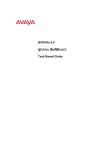

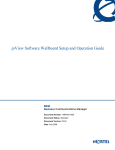




![Octopus` installation and user`s manual [v00]](http://vs1.manualzilla.com/store/data/005962625_1-a588a4c5f54c9235be7780e6e118b681-150x150.png)

